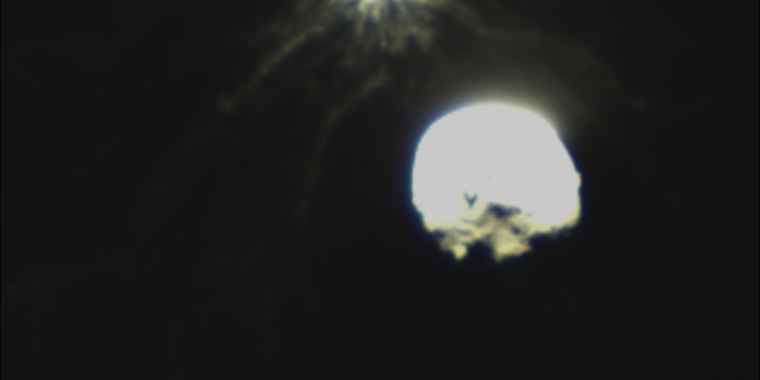

Sonda kosmiczna NASA Voyager 2 uchwyciła te widoki Urana (po lewej) i Neptuna (po prawej) podczas przelotów planet w latach 80. XX wieku. Źródło: NASA/JPL-Caltech/B. Johnson
Obserwacje z Obserwatorium Gemini i innych teleskopów ujawniają nadmierne zamglenie[{” attribute=””>Uranus makes it paler than Neptune.
Astronomers may now understand why the similar planets Uranus and Neptune have distinctive hues. Researchers constructed a single atmospheric model that matches observations of both planets using observations from the Gemini North telescope, the NASA Infrared Telescope Facility, and the Hubble Space Telescope. The model reveals that excess haze on Uranus accumulates in the planet’s stagnant, sluggish atmosphere, giving it a lighter hue than Neptune.
Planety Neptun i Uran mają ze sobą wiele wspólnego – mają podobne masy, rozmiary i składy atmosferyczne – jednak ich wygląd jest wyraźnie inny. Przy widzialnych długościach fal Neptun ma wyraźnie bardziej niebieski kolor, podczas gdy Uran ma jaśniejszy odcień cyjanu. Astronomowie mają teraz wyjaśnienie, dlaczego te dwie planety mają tak różne kolory.
Nowe badania wskazują, że warstwa skoncentrowanej mgły znaleziona na obu planetach jest grubsza na Uranie niż podobna warstwa na Neptunie i „bieli” wygląd Urana bardziej niż na Neptunie.[1] Jeśli nie ma mgły w atmosfera Od Neptuna i Urana, oba będą z grubsza równe na niebiesko.[2]
Ten wniosek pochodzi z modelu[3] że międzynarodowy zespół kierowany przez Patricka Irwina, profesora fizyki planetarnej na Uniwersytecie Oksfordzkim, opracował opis warstw aerozolu w atmosferach Neptuna i Urana.[4] Wcześniejsze badania górnych atmosfer tych planet koncentrowały się na wyglądzie atmosfery tylko przy określonych długościach fal. Jednak ten nowy model, który składa się z wielu warstw atmosfery, pasuje do obserwacji z obu planet w szerokim zakresie długości fal. Nowy model zawiera również rozmyte cząstki w głębszych warstwach, które wcześniej uważano za zawierające tylko chmury metanu i lodu z siarkowodoru.

Ten diagram przedstawia trzy warstwy aerozoli w atmosferach Urana i Neptuna, zaprojektowane przez zespół naukowców kierowany przez Patricka Irwina. Wysokościomierz na wykresie przedstawia ciśnienie powyżej 10 bar.
Najgłębsza warstwa (warstwa aerozolu 1) jest gruba i składa się z mieszaniny lodu siarkowodoru i cząstek pochodzących z interakcji atmosfer planetarnych ze światłem słonecznym.
Główną warstwą wpływającą na kolory jest warstwa środkowa, czyli warstwa cząsteczek mgły (nazywana w artykule warstwą aerozolu-2), która na Uranie jest grubsza niż na Neptunie. Zespół podejrzewa, że na obu planetach lód metanowy kondensuje na cząstkach w tej warstwie, wciągając cząstki głębiej w atmosferę, gdy spada metan. Ponieważ atmosfera Neptuna jest bardziej aktywna i burzliwa niż atmosfera Urana, zespół jest przekonany, że atmosfera Neptuna jest bardziej skuteczna w przemieszczaniu cząstek metanu do warstwy mgły i wytwarzaniu śniegu. To usuwa więcej zamglenia i sprawia, że warstwa zamglenia Neptuna jest cieńsza niż na Uranie, co oznacza, że błękit Neptuna wydaje się być silniejszy.
Nad obiema warstwami znajduje się rozszerzona warstwa mgły (warstwa aerozolu 3), podobna do warstwy poniżej, ale bardziej delikatna. Na Neptunie nad tą warstwą tworzą się również duże cząstki lodu metanowego.
Źródło: Gemini International Observatory/NOIRLab/NSF/AURA, J. da Silva/NASA/JPL-Caltech/B. Johnson
„To pierwszy model, który synchronicznie pasuje do obserwacji odbitego światła słonecznego od ultrafioletu do bliskiej podczerwieni” – wyjaśnił Irwin, główny autor artykułu badawczego przedstawiającego to odkrycie w Journal of Geophysical Research: Planets. „Jest także pierwszym, który wyjaśnił różnicę w widocznym kolorze między Uranem a Neptunem”.
Model zespołu składa się z trzech warstw aerozoli na różnych wysokościach.[5] Główną warstwą mającą wpływ na kolory jest warstwa środkowa, czyli warstwa drobinek mgły (nazywana w artykule warstwą aerozolu-2), która jest grubsza na Uran Z Neptun. Zespół podejrzewa, że na obu planetach lód metanowy kondensuje na cząstkach w tej warstwie, wciągając cząstki głębiej w atmosferę, gdy spada metan. Ponieważ atmosfera Neptuna jest bardziej aktywna i burzliwa niż atmosfera Urana, zespół jest przekonany, że atmosfera Neptuna jest bardziej skuteczna w przemieszczaniu cząstek metanu do warstwy mgły i wytwarzaniu śniegu. To usuwa więcej zamglenia i sprawia, że warstwa zamglenia Neptuna jest cieńsza niż na Uranie, co oznacza, że błękit Neptuna wydaje się być silniejszy.
Mike Wong, astronom w[{” attribute=””>University of California, Berkeley, and a member of the team behind this result. “Explaining the difference in color between Uranus and Neptune was an unexpected bonus!”
To create this model, Irwin’s team analyzed a set of observations of the planets encompassing ultraviolet, visible, and near-infrared wavelengths (from 0.3 to 2.5 micrometers) taken with the Near-Infrared Integral Field Spectrometer (NIFS) on the Gemini North telescope near the summit of Maunakea in Hawai‘i — which is part of the international Gemini Observatory, a Program of NSF’s NOIRLab — as well as archival data from the NASA Infrared Telescope Facility, also located in Hawai‘i, and the NASA/ESA Hubble Space Telescope.
The NIFS instrument on Gemini North was particularly important to this result as it is able to provide spectra — measurements of how bright an object is at different wavelengths — for every point in its field of view. This provided the team with detailed measurements of how reflective both planets’ atmospheres are across both the full disk of the planet and across a range of near-infrared wavelengths.
“The Gemini observatories continue to deliver new insights into the nature of our planetary neighbors,” said Martin Still, Gemini Program Officer at the National Science Foundation. “In this experiment, Gemini North provided a component within a suite of ground- and space-based facilities critical to the detection and characterization of atmospheric hazes.”
The model also helps explain the dark spots that are occasionally visible on Neptune and less commonly detected on Uranus. While astronomers were already aware of the presence of dark spots in the atmospheres of both planets, they didn’t know which aerosol layer was causing these dark spots or why the aerosols at those layers were less reflective. The team’s research sheds light on these questions by showing that a darkening of the deepest layer of their model would produce dark spots similar to those seen on Neptune and perhaps Uranus.
Notes
- This whitening effect is similar to how clouds in exoplanet atmospheres dull or ‘flatten’ features in the spectra of exoplanets.
- The red colors of the sunlight scattered from the haze and air molecules are more absorbed by methane molecules in the atmosphere of the planets. This process — referred to as Rayleigh scattering — is what makes skies blue here on Earth (though in Earth’s atmosphere sunlight is mostly scattered by nitrogen molecules rather than hydrogen molecules). Rayleigh scattering occurs predominantly at shorter, bluer wavelengths.
- An aerosol is a suspension of fine droplets or particles in a gas. Common examples on Earth include mist, soot, smoke, and fog. On Neptune and Uranus, particles produced by sunlight interacting with elements in the atmosphere (photochemical reactions) are responsible for aerosol hazes in these planets’ atmospheres.
- A scientific model is a computational tool used by scientists to test predictions about a phenomena that would be impossible to do in the real world.
- The deepest layer (referred to in the paper as the Aerosol-1 layer) is thick and is composed of a mixture of hydrogen sulfide ice and particles produced by the interaction of the planets’ atmospheres with sunlight. The top layer is an extended layer of haze (the Aerosol-3 layer) similar to the middle layer but more tenuous. On Neptune, large methane ice particles also form above this layer.
More information
This research was presented in the paper “Hazy blue worlds: A holistic aerosol model for Uranus and Neptune, including Dark Spots” to appear in the Journal of Geophysical Research: Planets.
The team is composed of P.G.J. Irwin (Department of Physics, University of Oxford, UK), N.A. Teanby (School of Earth Sciences, University of Bristol, UK), L.N. Fletcher (School of Physics & Astronomy, University of Leicester, UK), D. Toledo (Instituto Nacional de Tecnica Aeroespacial, Spain), G.S. Orton (Jet Propulsion Laboratory, California Institute of Technology, USA), M.H. Wong (Center for Integrative Planetary Science, University of California, Berkeley, USA), M.T. Roman (School of Physics & Astronomy, University of Leicester, UK), S. Perez-Hoyos (University of the Basque Country, Spain), A. James (Department of Physics, University of Oxford, UK), J. Dobinson (Department of Physics, University of Oxford, UK).
NSF’s NOIRLab (National Optical-Infrared Astronomy Research Laboratory), the US center for ground-based optical-infrared astronomy, operates the international Gemini Observatory (a facility of NSF, NRC–Canada, ANID–Chile, MCTIC–Brazil, MINCyT–Argentina, and KASI–Republic of Korea), Kitt Peak National Observatory (KPNO), Cerro Tololo Inter-American Observatory (CTIO), the Community Science and Data Center (CSDC), and Vera C. Rubin Observatory (operated in cooperation with the Department of Energy’s SLAC National Accelerator Laboratory). It is managed by the Association of Universities for Research in Astronomy (AURA) under a cooperative agreement with NSF and is headquartered in Tucson, Arizona. The astronomical community is honored to have the opportunity to conduct astronomical research on Iolkam Du’ag (Kitt Peak) in Arizona, on Maunakea in Hawai‘i, and on Cerro Tololo and Cerro Pachón in Chile. We recognize and acknowledge the very significant cultural role and reverence that these sites have for the Tohono O’odham Nation, the Native Hawaiian community, and the local communities in Chile, respectively.

„Introwertyk. Myśliciel. Rozwiązuje problemy. Specjalista od złego piwa. Skłonny do apatii. Ekspert od mediów społecznościowych. Wielokrotnie nagradzany fanatyk jedzenia.”





